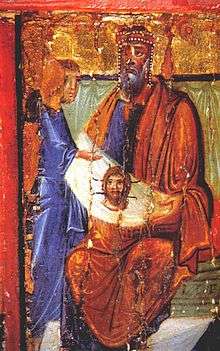Thaddeus of Edessa
| Thaddeus of Edessa Saint Addai ܡܪܝ ܐܕܝ | |
|---|---|
|
| |
| Born | c. 1st century AD |
| Died | c. 2nd century AD |
| Venerated in |
Assyrian Church of the East Chaldean Catholic Church Syriac Orthodox Church Eastern Orthodox Church Roman Catholic Church Oriental Orthodox Church Church of Caucasian Albania |
| Feast | August 5 |
According to some Eastern Christian traditions, Thaddeus, Syriac-Aramaic Addai or Aday (ܐܕܝ) (sometimes Latinized as Addeus),[1] was one of the seventy disciples of Christ, possibly identical with Thaddeus (Jude the Apostle) of the Twelve Apostles.[2]
Life

There is no consensus about life and death of Thaddeus of Edessa (Mar Addai / Mor Aday). Some historians and researchers dispute that he actually existed. Some also dispute that Thaddeus of Edessa and Addai are the same individual.
But based on various Eastern Christian traditions, Thaddaeus was a Jew born in Edessa, at the time a Syrian city, (now in Turkey). He came to Jerusalem for a festival, and heard the preachings of John the Baptist (St. John the Forerunner). After being baptized by John the Baptist in the Jordan River, he remained in Palestine. He later met and became a follower of Jesus. He was chosen to be one of the Seventy Disciples, whom Jesus sent in pairs to preach in the cities and places.[3]
After Pentecost and the Ascension of Jesus, Thaddeus started preaching the Gospel in Mesopotamia, Syria and Persia.[3] Thaddaeus ordained priests in Edessa, converted many to Christianity and built up the church there. He also went to Beirut to preach and founded a church there as well.
The Syriac liturgy referred to as the Divine Liturgy of Addai and Mari, originated around the year 200 A.D. and is used by the Assyrian Church of the East and the Chaldean Catholic Church that claim a connection to the saint and also by the Chaldean Syrian Church and Syro-Malabar Catholic Church in India founded by Judas Thomas the Apostle.
His feast is celebrated on August 5 in the Christian calendar.
Addai and the healing of King Abgar
| Part of a series on |
| Oriental Orthodoxy |
|---|
 |
| Oriental Orthodox Churches |
|
Subdivisions
|
|
History and theology
|
|
Major figures
|
|
|
Among the Eastern Orthodox faithful, Saint Addai was a disciple of Christ[4] sent by St. Thomas the Apostle to Edessa in order to heal King Abgar V of Osroene, who had fallen ill. He stayed to evangelize, and so converted[5] Abgar—or Agbar, or in one Latin version "Acbar" — and his people including Saint Aggai and Saint Mari.
The identity of the specific Agbar/Abgar however is open to interpretation: see Abgar.
The legendary tale of how the Armenian King Abgarus V of the Armenian kingdom of Osroene with capital city in Edessa and Jesus had corresponded was first recounted in the 4th century by the church historian Eusebius of Caesarea[6] In the origin of the legend, Eusebius had been shown documents purporting to contain the official correspondence that passed between Abgar and Jesus, and he was well enough convinced by their authenticity to quote them extensively in his Ecclesiastical History. According to Eusebius: "Thomas, one of the twelve apostles, under divine impulse sent Thaddeus, who was also numbered among the seventy disciples of Christ, to Edessa, as a preacher and evangelist of the teaching of Christ." (Historia Ecclesiastica, I, xiii)
The story of the healing Thaddeus' evangelizing efforts resulted in the growing of Christian communities in southern Armenia, northern Mesopotamia and in Syria east of Antioch. Thaddeus' story is embodied in the Syriac document, Doctrine of Addai, which recounts the role of Addai and makes him one of the 72 Apostles sent out to spread the Christian faith.[7] There are disagreements about the historical veracity of the tale. By the time the legend had returned to Syria, the purported site of the miraculous image, it had been embroidered into a tissue of miraculous happenings.[8] The story was retold in elaborated form by Ephrem the Syrian.
Various traditions
St. Addai appears in unorthodox material as well, in two previously unknown apocalypses attributed to James the Just found at Nag Hammadi in 1945.[9]
References
- ↑ Charles George Herbermann, The Catholic Encyclopedia (Universal Knowledge Foundation, 1913), p. 136.
- ↑ http://www.academia.edu/9074269/Judas_Thaddeus_Addai_possible_connections_with_the_vicissitudes_of_the_Edessan_and_Constantinopolitan_Mandylion_and_any_research_perspectives
- 1 2 "Apostle Thaddeus of the Seventy", Orthodox Church in America
- ↑ Sengstock, Mary C. (1982). Chaldean-Americans: Changing Conceptions of Ethnic Identity. Center for Migration Studies. ISBN 9780913256428.
- ↑ Herbermann, Charles George (1913). The Catholic Encyclopedia. Encyclopedia Press. p. 282.
- ↑ Eusebius, Church History, 1.13 and 3.1
- ↑ Luke 10:1 – 20
- ↑ Walter Bauer, Orthodoxy and Heresy in Earliest Christianity, 1934, (in English 1971) (On-line text)
- ↑ Robert Eisenman, James the Brother of Jesus : The key to Unlocking the Secrets of Early Christianity and the Dead Sea Scrolls, 1997 (Viking Penguin). Especially the section "Thaddeus, Judas Thomas and the conversion of the Osrhoeans", pp 189ff.
External links
- Saints Index: Sts. Addai & Mari
- Catholic Encyclopedia: The Legend of Abgar
- Catholic Encyclopedia: The Liturgy of Sts. Addeus and Maris
- Catholic Encyclopedia: Doctrine of St. Addai
- Syriac Orthodox: Doctrine of St. Addai - online text in English
- Thaddeus, Apostle of the Seventy - further Information